Text
Mix traditional news with social media and what do you get? Medium
It’s been a really really interesting week for Medium. In fact, some of the stories dropped onto the platform in the past few days have contributed to an exceptionally busy week in my regular full-time communications job, such that I’ve fallen a few days behind on my schoolwork (yikes). Nevertheless, we’ve heard more from Medium in mainstream media this week than we have in a while, making it the perfect time to explore its use.
Like blogging, but grown up

(Source: Medium.com)
To me, Medium has always represented a sort of evolution of the blogs and chat rooms of yesteryear. With an email alias and an opinion you’re willing to share with the world, it can be one of the quickest and easiest ways to establish yourself as a published writer and/or journalist (of sorts… since editing isn’t really a “thing” on Medium). There’s even the possibility that more established media outlets will source and republish content from Medium. As a communications professional, I’ve utilized Medium in the past to help publicize opinion pieces I’ve written on behalf of leaders within my organization that we hoped to get more eyeballs on. For example, in 2016 I wrote and published this Medium piece on behalf of the director of an organization I used to manage communications for. The piece would later go on to be picked up by some prominent publications, most notably with national education blog Education Post. There was always something a bit raw and scrappy about Medium, and that lack of refinement is why I never quite looked at it as a completely and totally legitimate media source. For that reason, it has never been a part of my regular media consumption habits.
...then, this week happened.
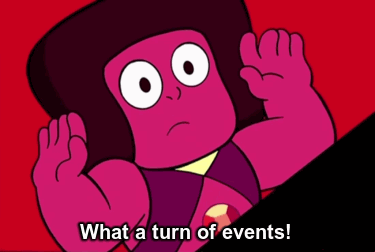
Not one but two major stories were posted to the platform this week, both of which gained international attention for different reasons… and I’d imagine that for anyone like me whose job is to monitor and report on social trends, Medium was definitely a topic of conversation at work this week (if anything, to explain to people what exactly Medium is). First, there was an emotional Medium post penned by model, actress and television personality Chrissy Teigen. Rather than turn to a high-profile television or magazine interview, Teigen chose Medium to share a personal, heartbreaking essay about the devastating loss of her unborn child just weeks ago with her husband, singer John Legend. Sadly, Teigen was in her 20th week of pregnancy and, as she is with most aspects of her life, was very transparent and open about the experience which resonated with people all over the world. The post has 54,000 claps as of Friday night (more on what claps are later).
Then the very next day, yet another big story dropped onto Medium. This time it was a surprising admission by Miles Taylor, former Chief of Staff for the Department of Homeland Security. After a Washington Post columnist shared earlier that day via Twitter that he’d spoken with the anonymous author of the 2018 New York Times op-ed, “I am part of the resistance inside the Trump administration,” and hinted that the public would also hear from them very soon, Taylor later outed himself, dropping “Why I’m no longer ‘Anonymous’”… on Medium. The post has 8.9 thousand claps as of Friday night.
Again, Medium has had a very very interesting week. The type of week that’s probably making myself and others who pay close attention to the media view it in a slightly different light.
The origins of Medium
Considering that Medium seems to be the type of platform where writers share their raw, somewhat unfiltered thoughts and ideas, it’s not totally surprising to learn it was founded by Ev Williams, one of the creators of Twitter and also the creator of Blogger. It launched in 2012 and, initially anyway, was by invite-only. At the onset, it was described as “a new place on the Internet where people share ideas and stories that are longer than 140 characters and not just for friends. It’s designed for little stories that make your day better and manifestos that change the world. It’s used by everyone from professional journalists to amateur cooks. It’s simple, beautiful, collaborative, and it helps you find the right audience for whatever you have to say.”
Although the site initially stood out from other blogging platforms because it sorted posts by topic rather than author (although that’s not totally the case today). According to data from Medium Blogging Guide, the site averages anywhere from 85 to 100 million active monthly users, and per a news report by Cheddar, may have between 200,000 to 400,000 paying subscribers. Alexa Rank, which effectively reveals how well your site is doing when compared to other websites, lists Medium as the 81st most popular website in the world in terms of traffic.
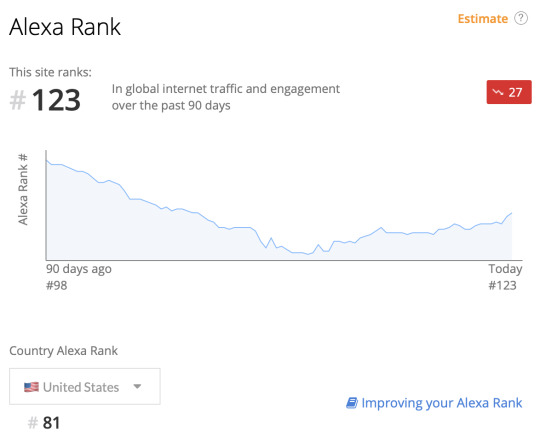
(Source: Alexa, an Amazon.com company)
The audience on Medium skews young and well educated. Citing data from Native Advertising, Search Engine Journal says that 95 percent of Medium’s readers are college graduates, and nearly half of them (around 43 percent) earn six figure salaries or higher. Half of its users are between 18 and 34 years old, and 70 percent are under the age of 50. As with pretty much all search engines and social media platforms, Medium relies on an algorithm to determine who is reading your posts, which impacts how and where your post is found within Medium. This algorithm is powered in part by “claps,” which is essentially the readers way to indicate that they liked a particular post. A user can post up to 50 claps per story, and more claps = more prominent placement on Medium. In that way, it’s functionality feels very similar to the upvote/downvote of Reddit, and the like/love/reaction features found on Facebook, Twitter, Instagram, and TikTok.
What are they even looking for on Medium?
It turns out that most of these young, somewhat affluent, and well educated individuals are on Medium looking for one thing: politics. Or at least that’s what data from 2016 suggests.
...I guess that means no one cared about my education reform piece? I mean, it’s kind of political when you think about it? Whatever, no hard feelings here, I was just doing my job.

From the onset, Medium hoped to capitalize on what it called “frustration with traditional news outlets,” which explains its expansion into Washington, D.C. and its sustained popularity as a source for political news. But it’s not just limited to politics, as sports, design, technology, startups, and entrepreneurship were also popular topics.
Ok, but what about #brands?
There are tons… and I mean tons… of blog posts and think pieces out there suggesting that with all the eyeballs and traffic Medium gets, it should absolutely be a part of anyone’s digital communications/marketing/brand strategy. But most of what I found were individual writers and reporters using Medium as a sort of refined blogging platform to further cement their reputation as an individual contributor. That, or more traditional news outlets like The Washington Post as content partners, posting some stories onto Medium but making those stories available only for paid subscribers. That’s not to say there are absolutely no brands making use of the unique blogging functionality of Medium. Online game streaming platform Twitch, for example, has used Medium as their way to share the type of content that resonates with the gaming community. They’ve got posts on new game discoveries and modifications, a deep dive into some of the inner workings of the company and why they do things the way they do, even a cool piece from one of the company’s interns detailing the day-to-day of her very cool internship.

(if I knew even the slightest thing about gaming, I’d clap for all of these)
Key takeaways and observations on Medium
My perhaps not-so-popular take is that considering how easy it is to set up and host your own blog on your own brand website (something that, for example, a simple-to-use hosting tool like Wordpress can allow you to do with ease), I don’t see a tremendous amount of value in adding your branded content to Medium. Perhaps there is some value for emerging brands, but even then, I think that until you have a regular story to tell, there is not a ton of value in adding a platform that functions more like a news media content blog than a way to showcase your brand.
More than anything, I feel like Medium caters to the individual, not companies, brands, or services. It’s not meant to be yet another digital storefront for your brand or service, but rather, is a place for (a) individuals to search for and read the type of stories they care about, and (b) for individual writers to share the types of stories they want to share without a significant editing process. I’m a firm believer that just because a tool or platform is out there does not mean that it absolutely has to be used by your brand. I just don’t think that’s what Medium is set up for. At best, it can be a place to help push personal interest and/or opinion pieces by senior leadership within your company or brand that might not be an ideal fit for traditional news publications. But at it’s core, it is a story publishing platform, and I think we should allow it to function as it’s meant to.
That being said, with all of the news that came from Medium this week (not to mention, all the major Medium posts that I’ve clearly missed in previous years) I’ll be adding it to my media consumption list going forward!
0 notes
Text
Instagram is for pretty pictures and pretty much nothing else
Instagram is absolutely positively hands-down my favorite social media network by far. I can spend hours scrolling, admiring makeup swatches, discovering emerging clothing designers, admiring nature photographers and food vloggers... or more often than not, obsessing over Tracee Ellis Ross’ #OOTD.
What I haven’t done with any degree of regularity? Tap into the Facebook-owned app as a source for actual information or media consumption of any kind. But as perhaps the world’s fastest-growing social media network, it makes perfect sense why many brands are turning to the network as a way to spread actual news and information. I see inherent challenges in trying to use the platform in this way, but it’s still highly interesting to explore what brands are doing this, and whether any are finding ways to make it work.
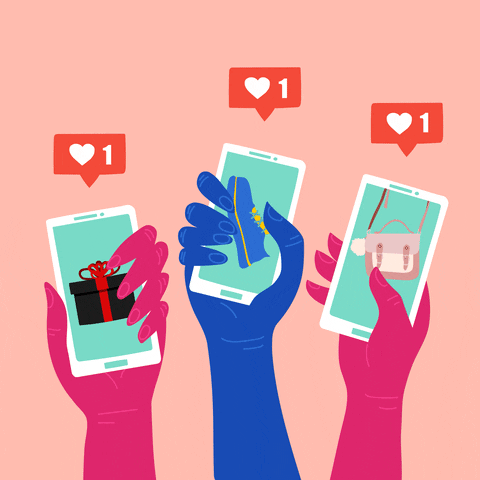
Fact: Everybody and their mom is on Instagram
As of June 2018, Instagram - the popular photo and video sharing app - hit 1 billion monthly active users. It’s appeal is extremely wide-ranging, and while it has always been especially popular among younger generations, older folks are getting in on the fun in increasingly higher numbers. According to Statista, 33.8 percent of Instagram’s global users are between the ages of 25 and 34 -- the largest audience represented among the platform's users. Just behind this group are users age 18 to 24 (29.3 percent) and users age 35 - 44 (15.9 percent). But frankly, there really isn’t an age group that’s not using Instagram! Even 2.2 percent of people age 65 and older are using it.
Aside from age, it was interesting to learn more about which sub-audiences are most likely to use Instagram. A report from the Pew Research Center suggests that women and Hispanics are the most likely to use the app, saying that 43 percent of women vs. 31 percent of men say they use Instagram, and that 51 percent of Hispanic adults say they use Instagram, when compared with 40 percent of Black adults and 33 percent of white adults.

(Source: Statista)
Shopping? Yes. Celeb gazing? Sure. News? Maybe not.
With ALL of these global eyeballs fixated on one social platform, you’d think that virtually any type of content posted to Instagram would go viral almost instantaneously. It turns out that this isn’t exactly the case, and that the highly visual social platform doesn’t lend itself to just any type of media content. In looking at the same data set from Pew Research Center, it turns out that only one out of seven adults turn to Instagram for news, with a large share -- 42 percent -- saying they actually don’t trust Instagram for information like political and/or election news. Considering that a fair amount of people (29 percent) are aware that Instagram is owned by Facebook, and that 59 percent of people say they don’t trust Facebook as a source for political and/or election news (surprise surprise), one could conclude that this might be a reason why.
In my opinion, the explanation is far simpler than that. Simply put, people go on Instagram for one reason and one reason alone: pretty pictures. Instagram is an escape from reality, and a chance to look at beautiful images of the lives we dream of living, the wardrobe we dream of having, the gorgeous plate of food we dream of being able to cook, so on and so forth. It’s quite telling that the most-followed Instagram accounts (aside from Instagram itself) aren’t news or information based, or even consumer focused, but rather, are of aesthetically pleasing celebrities. As of October 2020, the three most-followed Instagram accounts after Instagram itself were Cristiano Ronaldo at 1967.68 million followers, Ariana Grande at 171.5 million and Dwayne “The Rock” Johnson with 171.5 million followers. What do these three (plus the rest of the top 10 most-followed accounts) have in common? They’re attractive, they’re famous, they’re rich, and they use their accounts to give us regular folks a glimpse into the glamorous lives they live.

...like I said, pretty pictures.
Habits of the average Instagram user
Considering that not all of us are Ariana Grande or The Rock, not to mention the fact that we’re more likely to turn to sites like Twitter for news and information, what exactly are these billion or so people actually doing on Instagram? Here’s where I think there’s a strong business case for consumer-based marketers, but perhaps not so much for news and information-based businesses. Data from Hootsuite suggests that 200 million Instagram users visit at least one business profile daily, and that 62 percent of Instagram users have become more interested in a business after seeing a brand or product in Instagram Stories -- a short form, video feature of Instagram that gets about 500 million visitors every day. Shoppable posts, a newer feature of Instagram which allows users to tap an image to purchase what’s featured in the photo, are utilized by 130 million Instagram users every month. And more than 50 percent of Instagram users visit the Explore tab -- a section of Instagram where recommended businesses or pages can show up in your feed.
A number of brands are doing a wonderful job using Instagram, and I’ve certainly succumbed to their clever and effective marketing tactics! Singer and businesswoman Rihanna, for example, focuses heavily on Instagram to market her several growing brands, most notably Fenty Beauty by Rihanna, her ultra-inclusive line of cosmetics that has disrupted the beauty industry. The feed is beautiful and aesthetically pleasing, and as part of their business strategy, Fenty Beauty chooses to highlight regular people as models and brand ambassadors, encouraging users to upload and tag their own makeup looks with #FentyBeauty for a chance to be featured to the page’s more than 10 million followers. With a few taps, Instagram users can identify a look they love and be directed right to Fenty’s e-commerce site to purchase the products featured in the Instagram post.
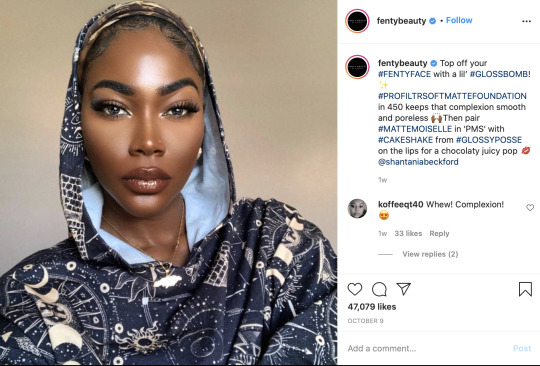
(Source: Fenty Beauty by Rihanna on Instagram. By tapping this photo, users are directed to an e-commerce site where they can purchase the products used to create this glamorous look.)
As far as news and information, I see a lot of brands trying and doing an alright job, but unless there is a highly visual element to the work being done, Instagram just isn’t especially suited to this type of content. One notable exception is National Geographic. While their Instagram feed is highly informative, it’s really the beautiful nature photos that sets their Instagram presence apart from other media outlets. Photography has always been vital to NatGeo’s success, and their Instagram feed is a perfect place to showcase this part of their work. In fact, their bio reads “experience the world through the eyes of National Geographic photographers.” The captions are brief and informative, but the photos are what really draws you in.
No writers, no longform thinkpieces. Just. Pretty. Pictures.

(Source: NatGeo on Instagram)
Stick to what you’re good at
As a communications and marketing professional with a background in news, Instagram has always been a part of my toolbox. But the only time I would say it’s really worked is when I’m in a business where there are incredibly strong visuals to work with where the photos themselves can be the story, the content, and the brand. It doesn’t benefit a business to launch on Instagram with no real plan for visuals, rather with the hope that because there are simply a ton of people on the platform that somehow all of the rest of our work will translate onto the site. As a news and information platform, it simply doesn’t work. People log onto instagram to look at beautiful images, then scroll and look for more beautiful images, and more likely than not, to make some buying decisions based off of those beautiful images. So for brands and businesses that have the luxury of being able to tell a full story in an image or short video, Instagram will continue to be a critical part of their marketing strategy.
0 notes
Text
Going, going, (not quite but almost) gone: the sad state of local newspapers
True story: As a young, would-be journalist, I applied at the behest of my high school journalism teacher to the Hugh N. Boyd Minorities in Journalism Workshop. The program was a two-week intensive workshop open to high school students across New Jersey with an interest in journalism. It promised to provide the 15 or so selected participants with real-world experience in the field absolutely free of charge, as local newspapers across the state sponsored the event, covering all expenses for selected students. Having always been rather introverted and somewhat shy, I didn’t think my writing was good enough to make the cut. But to my surprise, I ended up being selected and was sponsored by my hometown newspaper, The Record of Bergen County, aka The Record (or, so it was called at the time). The experience was transformative for me, and gave me my first insight into life as a journalist. I’d go on to study journalism as an undergraduate student at the University of Florida, starting off in print but switching to broadcast, and working professionally in the field for more than a decade for CNN, NBC, ABC, Univision, and more. And for a time, I briefly took a job as the lead social media editor for none other than the local newspaper that helped give me my start in the business: The Record of Bergen County.

(fun fact: The Record broke the 2013 George Washington Bridge lane closure scandal which made national and global headlines)
This week, I chose to take a closer look at local newspapers, and in doing so, briefly examine why they’ve struggled to remain relevant in a changing industry (I’ll only scratch the surface, because I could probably write an entire dissertation on this topic). It’s actually quite sad, as I firmly believe that local newspapers and beat reporters are critical to freedom of the press and unbiased, balanced, and fair reporting. Sadly, the digital age has done irrevocable damage to this industry. And I hate to say it, but digital and social media are almost solely responsible for the demise of newspapers, and sadly, I’m a part of that problem too. As a tail-end millennial who came of age with the internet, if the news isn’t on my smartphone or easily accessible via an app or a free website, I quickly lose interest and seek my information elsewhere. I can’t remember the last time I had a newspaper subscription, or even purchased a newspaper. I recognize how important they are, I just have so many other options for news consumption now that I just don’t turn to newspapers anymore.
Freedom of the press
Local newspapers have been part of the fabric of this country since as early as the 1600’s. Every journalism student remembers studying the great circulation wars of the 1800’s between Joseph Pulitzer and William Randolph Hearst. If not, everybody remembers how fun it was when instead of class, our teachers took a day off from teaching and instead showed “Newsies” on VHS in history class. It never gets old.
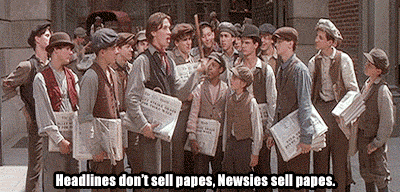
(truer words have never been said, Jack Kelly)
But the rise of television news, and eventually digital and social media, pushed local newspapers aside, as audiences had a quicker, easier way to access news on-demand instead of waiting for the morning paper. According to a recent report by researchers at the Hussman School of Journalism and Media at the University of North Carolina at Chapel Hill, 300 more newspapers failed since the fall of 2018 bringing the death toll to 2,100. That’s 25 percent of the 9,000 newspapers that were being published just 15 years ago. It also noted that there are about 200 “news deserts,” or communities without any local newspapers. Most of those news deserts are in economically challenged rural areas, but more and more, even the economically advantaged suburbs are feeling the pinch too.
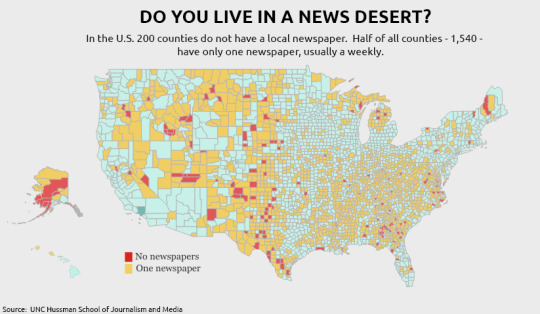
(via UNC Hussman School of Journalism and Media)
The danger here? Local papers highlight and elevate local stories we might not otherwise know about, but we absolutely need to care about. What’s going on in our schools, with our local elected officials, within our communities, local zoning and budget decisions that impact our daily lives. They provide a micro-level guide to the things that impact us every single day. So if nearly all of your news is coming from social and digital media and their sometimes questionable algorithms, or television news that’s almost undoubtedly biased (at least in the U.S.), you really have to question whether you’re receiving fair, unbiased coverage.
Dying, but not (quite) dead
It was encouraging to see that while the industry is undoubtedly suffering, there are still some people who often consume their news via local newspapers. According to the Pew Research Center, people aged 65 and older account for most of the existing newspaper audience, roughly four in 10 of whom say they still often get their information from newspapers. This is about what I would expect from the older generation, but this sadly doesn’t say much for younger generations and their newspaper consumption. Only 18 percent of people age 50-64, 8 percent of people age 30 to 49, and a mere 2 percent of people age 18-29 say that they often get their news from newspapers.
And even among those 65 and older, newspapers are a pretty distant second in terms of the source they visit most often for news, as 81 percent of people in this age group cite television as the source they often use for news.
If you can’t beat them, join them
In my brief time as social media editor for The Record, it was obvious to me that the paper was trying hard to adapt to a changing world, opening themselves up to methods they’d never had to use before. The same was true of most newspapers, even national newspapers like the Los Angeles Times and the New York Times. It has been interesting to see the ways in which these newspapers have branched out into new forms of media to adapt to the way people consume news today. I highlighted this in a previous post, but I’ve been impressed by the NYT’s foray into LinkedIn Live, creating immersive, engaging conversations on key stories, and giving the audience the chance to actively participate with the media. At its core, I’ve always said that the best thing about social/digital media was that it took what were always one-way conversations, and made them into two-way experiences for the audience and the content creator. And speaking of the Times, their efforts on Instagram are among my favorite. Beautiful portraits that would once only live on paper are now shared in a beautifully curated feed that is always so pleasing to the eye. Often, these are stories that wouldn’t typically make the front page of the paper, but the visuals are so stunning that they tell a story in and of themselves.
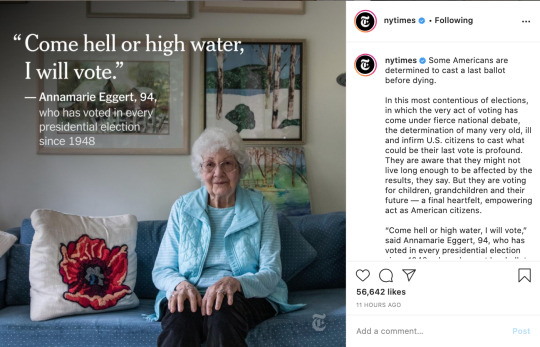
(via the New York Times on Instagram)
Using local newspapers as a communications professional
Part of my renewed interest in newspapers came about when I was a communications manager for a small nonprofit organization. Our primary goal was to engage in state level advocacy on behalf of the state’s charter schools. Effectively that means, catch the eyes and ears of lawmakers and state your case so that when budget time comes around, they’ll make sure to enact a budget that ensures the survival of these schools. I learned that these lawmakers and influencers pay close attention to newspapers, perhaps even more than other forms of media, and so getting our agenda into the local newspaper was a large part of the work that I did. I would write (well, ghostwrite) opinion pieces for senior leadership, students and parents, and pitch them for placements in the local papers in the districts of the lawmakers we needed to reach, I would develop relationships with local education reporters, invite them to press events, give them quotes for their stories, organize editorial board meetings and more. Newspapers became a critical part of the work that I did, as were the relationships I built with members of the newspaper industry, and I’d imagine the same is true for other communications professionals.
Much to my (pleasant) surprise, there are still some brands doing important work with traditional print newspapers. According to FORBES, “MasterCard placed a two-page spread in The New York Times, almost unheard of these days, to articulate its support for the LGBTQIA+ community and MasterCard’s support for GLAAD’s NEON Legacy Series, a photo and video collection produced by Black LGBTQIA+ creators. The ad states MasterCard’s commitment to equal treatment, equal opportunity and equal rights. The ad features both the MasterCard logo and the GLAAD logo.” I can’t find a photo of the ad anywhere, but I’m sure it was great!
Of course, this is very different from the way the general public engages with newspapers, as they’re looking for unbiased updates on what’s going on in their communities. But it’s still nice to know there are still some communicators out here tapping into the power of local newspapers to promote their brands, and I was one of them.

(sigh. a beautiful sight)
A sad future for local newspapers
Sadly, none of the statistics point to a revival of newspapers anytime soon, although I’m holding out hope. With fewer local papers, and increased reliance on (often biased) television and (often wrong) social media for news, I worry that this is just one of the unfortunate ills of the digital age we’re living in. Sadly, many local papers are unable to stay afloat despite employing every possible adaptation in the book, often succumbing to major buyouts by huge conglomerates, resulting in newspapers that are controlled by corporate interests and offer no true local, unbiased reporting.
And as for The Record? It suffered a similar fate in 2016 after it was ultimately bought out by Gannett, the nation’s largest newspaper chain. For folks like me from northern New Jersey, it was the end of an era. I still remember being saddened when I learned the news, even feeling a tad guilty that I didn’t stick around long enough to perhaps contribute to a more favorable outcome. While my time there was brief, I worked alongside some of the smartest, most passionate and hard-working people I’d ever met. They lived and breathed northern New Jersey, and they put their heart and soul into every letter of every story that went to print. But what happened with The Record has sadly happened to so many local newspapers with no signs of slowing down.
As communications and marketing professionals, we certainly can play a role in trying to help revive the industry, but my fear is that any efforts we make would be too little too late.
0 notes
Text
Reddit: The so-called “front page of the internet” that’s equal parts fun and frightening
Although it describes itself as the “front page of the internet,” Reddit has always been a bit of a mystery to me, and that’s saying a lot for an alleged millennial who came of age with the world wide web. Sure, it pops up alongside Quora every single time I conduct a random Google search, but aside from being co-founded by Serena Williams’ husband (sorry but I’d never heard of Alexis Ohanian until they wed, so this is who he’ll always be to me), there’s little to nothing I know about the site, who uses it, or why. As it turns out, I am totally in the minority, as Reddit is one of the most popular sites on the internet. I think I owe it to myself, and to Queen Serena, to take a deep dive.

(Serena Williams, literal royalty, and guest... who apparently co-founded Reddit)
Prior to this week, the extent of my knowledge of Reddit was that it was some sort of online message board where people shared weird memes, commented on obscure stories, and in some extreme cases, gathered in secret to plan acts of violence or harm. Needless to say, I thought Reddit was a pretty weird place that I should probably avoid. To a degree, some of these things are true. But in its purest form, Reddit is simply a user-focused way to read the news you care about.
Reddit, then and now
Launched in 2005 by recent college graduates Steve Huffman and the aforementioned Alexis Ohanian, Reddit has surged in popularity with more than 430 million active monthly users. According to Tech Junkie, Reddit “works like a newspaper, but with users who are entitled to their own opinion.” At its core, Reddit is a news and topic message board. At first glance, what I find incredibly interesting is just how no frills the site is. No fancy graphics or complicated code, Reddit looks like something I could’ve created on my old school Macintosh desktop from middle school. And from what I can gather, that vintage appeal is part of what Reddit users seem to love. It doesn’t feel especially polished, rather, it’s a site that really feels like theirs. The content you see (or, don’t see) is populated based on the interests of its many many millions of users. Rather than a homepage editor determining which stories and topics to feature prominently, Reddit users submit posts which other users then either “upvote” if they like it, or “downvote” if they’re not impressed. Posts and content with the most upvotes naturally move up the rankings and therefore show up in more feeds and are shown to more users, while less popular downvoted content gets pushed down and eventually out. Content is categorized into different categories, or “subreddits,” with each subreddit filtering onto the main Reddit page. This gives any single piece of content, depending on the number of upvotes it receives, the power to potentially reach the front page of the site.
Ok so, the whole “front page of the internet” thing is making a lot more sense now.
Mixed feelings on Reddit users
Admittedly, I have my own assumptions about the type of person who is probably active on Reddit, and it’s not the most favorable assumption. I’m certain that this is due to some of Reddit’s more controversial aspects. Because the site requires little more than a username and valid email address to join, it fosters an element of anonymity, which can be both good and bad. For years, there have been Reddit communities bound by extremist views and hate speech, as well as the vile and intrusive leaks of private photos of celebrities (most of these victims, of course, have been women). Based on my own internal moral compass, it can be hard to overlook these controversies and see Reddit as a valuable media source, and to think very highly of anyone who uses the site regularly.
Speaking of, it’s incredibly difficult to determine exactly who is using Reddit because of that aspect of anonymity, but it’s fairly easy to guess. By citing third-party polls on general internet usage, TechCrunch was able to make an educated (and likely valid) guess that Reddit’s users skew overwhelmingly young, white, and male. Data from the Pew Research Center suggests this group may account for as much as 71 percent of Reddit users.
There’s still some good (and some brands!)
Still, I wouldn’t want to say that Reddit is all bad. Nor would I want to assume that every single user on the site is there for nefarious reasons. Reddit is also known for extremely positive communities, or subreddits, that share uplifting news and offer a breath of fresh air among the 24/7 news cycle where most headlines revolve around death and despair (or have all seemed to, as of late). For example, the Made Me Smile subreddit has 2.4 million members and shares nothing but heart-warming content intended to brighten up your day. Subreddits like these are a reminder that the world can (and should) be a kinder, more wonderful place.
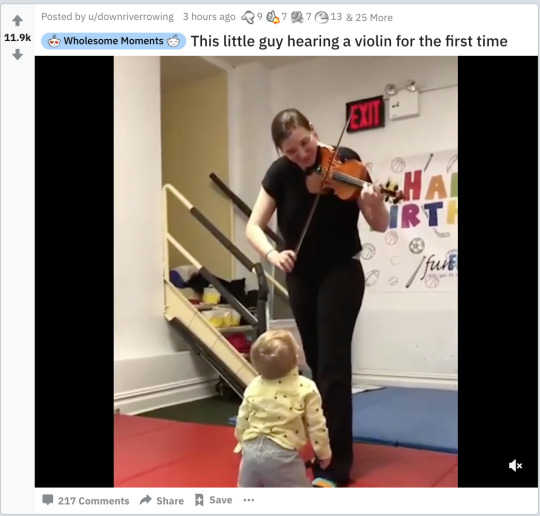
(brb, heart melting)
Much to my surprise, there are some brands that have successfully tapped into Reddit’s unique functionality as a marketing tool. Luxury car manufacturer Audi, for example, took advantage of the platform’s popular Ask Me Anything series (where celebrities answer pretty much any user-submitted question) by having celebrities host their own AMA’s while speeding around in the latest Audi model. Kind of weird, and I really couldn’t tell you if it helped Audi sell any more cars, but at least they tried? Marriott also tried their hand at a Reddit campaign, challenging users to “get teleported.” The hotel chain partnered with Oculus to create virtual travel experiences, then challenged Reddit community members to respond to the thread explaining why they deserved to be teleported, allowing users to be as creative as they wanted with their entries. When it was all said and done, Marriott Hotels achieved almost 200,000 clicks on its contest page and Reddit's (then) highest ever user-generated content for sponsored posts. Not to mention, Marriott won a Webby Award for their efforts.

(Olivia Munn. In an Audi. Doing an AMA. Unimpressed.)
Main takeaways
Based on what little knowledge I was able to glean on Reddit from my research this week, I see a whole lot of potential good, but at the same time, way too much bad to ever be truly comfortable as a user of this site. While I do enjoy the user-focused nature of Reddit, I worry about just who those users are, why they’re there, and whether that makes Reddit a safe space for me to be. Yet and still, I commend brands that are creative enough to try their hand at adding Reddit to their digital communications strategy. In all honesty, were I challenged to use Reddit in this way, I might find it fun and creative. As for my personal media consumption, however, I’ll continue to stay far away.
Until my next random Google search lands me on somebody’s subreddit. Again.
0 notes
Text
Beyond job hunting, *what* is LinkedIn for?
Once upon a time, LinkedIn was little more than that obscure site that seemed to pop out of nowhere, and we only learned we were on it after Googling ourselves (no judgment, we’ve all done it). If you’re anything like me, your first reaction was what on earth is this, and more importantly, um, why does this thing know where I work?!? But in time, LinkedIn grew to be a sort of news/social networking/career development one-stop-shop, and more recently, a legitimate source for media consumption and a must-have for landing your next gig. Not a bad growth arc there, LinkedIn.
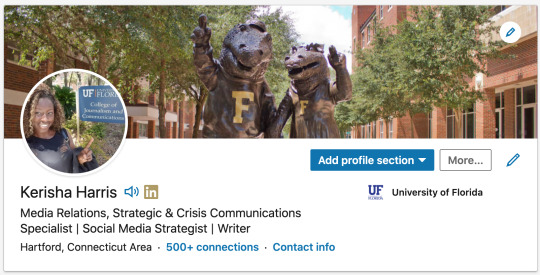
(hey, I know her!)
Why LinkedIn’s growth is different
Founded in 2002, LinkedIn struggled for a bit to find its footing among a social media field that was growing ever-more crowded by the minute. For a while, its purpose was a little unclear. Is it for job hunting? Bragging about our latest career development? Stalking the dream company we wish we worked for? No one was certain. Part of why the network grew the way it did was that unlike other social networks that require users to opt-in and join, your initial LinkedIn profile was generated for you based on your publicly available employment information, you just had to claim yours. So as LinkedIn began to grow and refine itself, most of us were already on the platform and able to take advantage. And while Facebook and YouTube continue to (unsurprisingly) dominate the social media landscape, LinkedIn has slowly but surely increased in popularity. According to Social Media Today, LinkedIn is now up to 690 million total members. Unbeknownst to me, Microsoft acquired LinkedIn in 2016 for $26.2 billion, and as recently as 2018, LinkedIn contributed $5.3 billion in revenue to its parent company. That’s because unlike other social media platforms that rely on advertising, LinkedIn offers career-building opportunities that users are willing to pay to unlock, such as help with sales and hiring.
Real tips from real pros
youtube
(Self Made Millennial says LinkedIn’s algorithm looooves native content)
Although I am happily employed in a new role I’m thrilled with, I admit to checking LinkedIn almost daily. For the most part, I visit to be nosey to learn more about where my former colleagues are working, what projects they’re up to, and frankly, what companies are hiring for my specific skill set (it’s how I landed the job I have now, so thanks LinkedIn). Far less frequently, however, do I visit LinkedIn to consume media. For that, I turn to email lists I’m signed up for, like The Morning via the New York Times, Twitter, and my Apple and Google news alerts. But interestingly enough, times are changing and LinkedIn has become a place for thought leadership, think pieces, career-related blogs, and long-form media content.
Writing for Kinsta, Maddy Osman notes that content on the LinkedIn feed, inclusive of articles written on/for the platform, generates 9 billion (woah!) impressions per week, and that it drives more than 50 percent of social traffic to B2B sites. A study by OKDork found that how-to articles, long-form content, and posts that included at least eight images were among the top-performing pieces of content. Interestingly though, only a tiny percentage of LinkedIn users are posting content to the site regularly.
What I do like about LinkedIn’s content feature is that unlike a piece from WSJ or CNBC, I’m not hearing from a journalist on a specific beat looking to scoop the industry. Rather, I’m hearing from real professionals offering advice based on their own experiences and lessons learned throughout their careers. I see some potential value in that. Still, with so few users actually creating the content, it’s hard to say whether any of the media found on LinkedIn is helping or advancing the brands or influencers creating it.
The real struggle? Doing LinkedIn “right”
Because LinkedIn is still kind of figuring out exactly what it is and who it’s for, I haven’t seen too many brands actually master a LinkedIn presence that makes sense or adds real value. Full disclosure: most of my engagement on LinkedIn as a communications and marketing professional has been to remember to post something (ok, anything) on it at least every few days just to say I did. Terrible, I know, but I have it on good authority that I’m not the only one. It seems fewer people engage with LinkedIn looking for news or media, but rather, are there looking for career growth and development. According to Osman’s deep-dive into the numbers of LinkedIn for Kinsta, more than 20 million companies are listed on LinkedIn and 90 percent of recruiters are using it to fill more than 14 million open jobs. In terms of who is using LinkedIn, the Pew Research Center notes that LinkedIn is most popular among college students and graduates, as about half of college grads use the platform, compared with a mere 9 percent of people with a high school diploma or less using it. It seems pretty clear that students, as well as educated working professionals, are using it for reasons primarily tied to career development and networking.
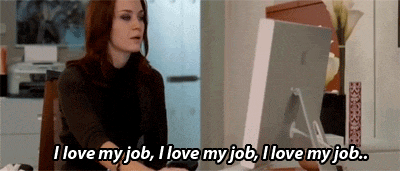
(Emily preemptively looking for the next Emily on LinkedIn)
What’s the future for LinkedIn?
I commend LinkedIn for its efforts to innovate and turn itself into more than just a job-hunting and recruiting tool. Recent rollouts like LinkedIn Live for business pages allow brands to combine the best parts of interactive social media and smart career development, and reach their audience in new ways. A real standout here in my opinion would be the New York Times, which has tapped into LinkedIn Live to bring together journalists and subject matter experts for live, interactive video conversations. But in reality, I think LinkedIn is just too much of an outlier, and that it can only mimic the best of what other digital and social networks have to offer.
Looking for the next great gig? LinkedIn’s your jam. But beyond that, I think I’ll stick to the other guys.
0 notes
Text
Why the cool kids (and brands who hope to be perceived as such) are on TikTok
Being what I like to describe as a “tail-end millennial,” I’ve grown up both with and in the digital age. I still remember turning in school assignments completed on a typewriter as well as playing Oregon Trail in computer class on those box-shaped, neon green Macintosh screens (I’m still heartbroken that my wife died of dysentery, btw). I remember pleading with my mom to hang up the phone so I could log onto AOL, and how much thought I’d put into curating the perfect AIM away message. I joined Facebook my senior year of college when it was still “the Facebook” and for college kids only, and remember how big a deal it was to rearrange my MySpace top eight (funny how we were full-on coding and didn’t even realize it). But now, as a mom of three tweens, I can admit that despite digital and social media being both my personal experience and my chosen career, there are media formats out there that I know nothing about, and that my kids’ knowledge far trumps my own. None of these formats feel more foreign to me, yet obviously influential and equally important to the next generation, than TikTok.
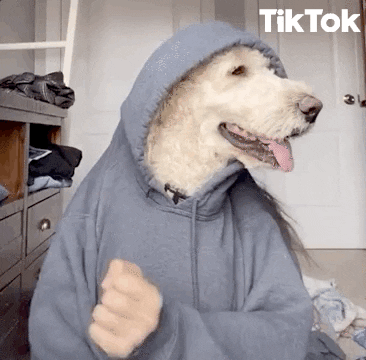
What is TikTok and (dancing humanoid dogs aside) who uses it?
TikTok is, by and large, the newer, cooler and way more sophisticated version of Vine (RIP to a real one). On its own website, TikTok says its mission is to “inspire creativity and bring joy.” Produced and manufactured by Beijing-based video-sharing service ByteDance, TikTok reportedly boasts 800 million users worldwide, and as of 2019, has surpassed one billion installs (Yeh, 2019). It creates and curates an experience driven by its powerful algorithm, turning all of its users into a connected network of mini-influencers through the use of trending hashtags, leveraging of popular music, and push for engagement with other users through duets and viral dance challenges, making for a meaningful, organized, and dare I say it, super fun experience for users of the app (Herrman, 2019).
In exploring the app, what I found especially interesting was the way TikTok employs a vertical feed experience prompting the user to swipe up, which sets it apart from similar apps like Instagram Stories or Snapchat. This “endless scroll” approach seems, in my opinion, very conducive to creating an almost addictive experience which can lock you in for hours and hours. TikTok appears to cleverly take advantage of the way users normally engage with our vertical screens, filling up the entire real estate of our phones with engaging video content coupled with popular music that’s perhaps a little too easy to get sucked into.
Who is TikTok really for?
As not only a mom of tweens, but also having worked in communications within the education space in various capacities since 2016, TikTok’s popularity among young people comes as no surprise to me. TikTok is primarily used by youth between the ages of 16 and 24 (Brucker, 2020). It is used by about 69 percent of young people in the U.S., and these users spend at least 80 minutes per day on the app (Perez, 2020). This is the same group that, if you ask them, considers Facebook to be that “cringey” old people app that your grandpa thinks is cool, and Twitter to be that thing where journalists and politicians bicker with other journalists and politicians. It’s unsurprising to me that young people would be attracted to TikTok, a space that can feel exclusively like their own.
For me, it is that young people's exclusivity that keeps me away from TikTok. Despite being what many consider to be a subject-matter expert on social media, I am admittedly intimidated by an app I don’t completely understand or feel welcomed on. I feel more comfortable with the apps I’ve come of age with and whose functionality is more native to my own digital experience, most notably Facebook, Instagram, and Twitter. I worry I may look like I’m “trying too hard” by exploring TikTok, or worse, that my presence there as a 38-year-old mom will render it an uncool place to be. My own kids reacted with horror when they noticed I had TikTok installed on my work phone, it didn’t matter that my job was to manage my then-employer’s institutional presence on social media. “Mom, please don’t make Wesleyan University a TikTok” they begged (too late guys, already secured the username for posterity). It was clear that they viewed TikTok as their safe space, and that my presence, as well as my employer’s presence despite it being an elite, well-known university, was not welcome.
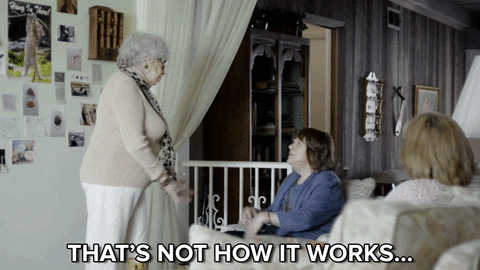
Are any grownups or brands doing TikTok “right?”
Interestingly, several marketers have managed to get past this “eww, adults and brands” factor to effectively market to TikTok’s growing audience through clever advertising and engagement campaigns. Capitalizing on the popularity of hashtag challenges on TikTok, Universal Pictures turned to TikTok as a way to promote their 2018 film, The House with a Clock in Its Walls, through a #FindYourMagic campaign which prompted users to film themselves doing their own magic tricks. Leveraging the power of influence, Universal got a group of popular TikTok influencers to post their own DIY magic videos, which naturally prompted others to do the same. As a result of the campaign, Universal received 1.3 million likes on the influencer videos, generated 19,000 pieces of user-generated content, and gained 11,000 new followers (Brucker, 2020). Whether it prompted people to actually go see the film, I’m not really sure.

(Source: TikTok for Business)
In my work as a higher education social media manager, I often came across other universities (typically, with bigger teams and even bigger budgets) doing great work on TikTok. From a marketing perspective, it makes sense why a university would want to invest in building an exceptional presence on TikTok. Each year, so much of your energy and efforts are dedicated to marketing to prospective students and their families, convincing them that your school is the school to attend. Based on user demographics alone, TikTok offers a captive audience for the exact age range higher ed marketers are working so hard to reach. I’m proud to say that my undergraduate alma mater, the University of Florida, was one of the first to leverage TikTok and is considered one of the best in the game. With nearly 97,000 followers and more than 1 million likes, it’s clear they’ve figured out what resonates with their audience. Most of their TikTok videos feature the beloved school colors (anyone who went to UF will tell you we bleed orange and blue), Al the Alligator (we obviously weren’t terribly creative on the mascot name), fave spots on campus and the like.
youtube
(Source: University of Florida on YouTube)
Other major schools like Brigham Young University and Florida International University capitalize on TikTok’s penchant for dance trends and employ their mascots, Cosmo the Cougar and Roary the Panther respectively, to jump in on these trends.
youtube
...this same video on BYU’s Cosmo the Cougar TikTok has a staggering 28 million plays, 4.8 million likes, and more than 24,000 comments.
Is TikTok here to stay?
As a perpetual student of digital and social media, I see TikTok as the wave of the future for digital and social communications and marketing. The question for me, however, is whether or not I’m going to ride that wave as a communications professional. While digital marketing is still somewhat new on TikTok, my constant fear is that the moment brands step in and try to inject themselves onto a platform, mimicking and profiting off of the way it is organically used, its core users become disinterested, abandon the platform, and look for the next big thing they can call their own. If I’m lucky, perhaps I’ll get the next big idea and launch that platform myself.
Funny but true story. As I was putting the finishing touches on this blog post, my 12-year-old daughter came up behind me chanting the following.
Her: Racism? Stop it. Bullying? Stop it. Homophobia? Stop it.
Me: Is that from a TikTok?
Her: Yeah.
Me: Figures.
SOURCES:
Brucker, N. (2020, January 6) Who is on TikTok and how can brands reach them? Forbes. Retrieved from https://www.forbes.com/sites/forbesagencycouncil/2020/01/06/who-is-on-tiktok-and-how-can-brands-reach-them/#1a2fe28343be.
Herrman, J. (2019, March 10) How TikTok is rewriting the world. New York Times. Retrieved from https://www.nytimes.com/2019/03/10/style/what-is-tik-tok.html.
Perez, S. (2020, June 4) Kids now spend nearly as much time watching TikTok as YouTube in the US, UK and Spain. Tech Crunch. Retrieved from https://techcrunch.com/2020/06/04/kids-now-spend-nearly-as-much-time-watching-tiktok-as-youtube-in-u-s-u-k-and-spain/.
Yeh, O. (2019, February 26). TikTok surpasses one billion installs on the App Store and Google Play. Sensor Tower. Retrieved from https://sensortower.com/blog/tiktok-downloads-one-billion.
1 note
·
View note